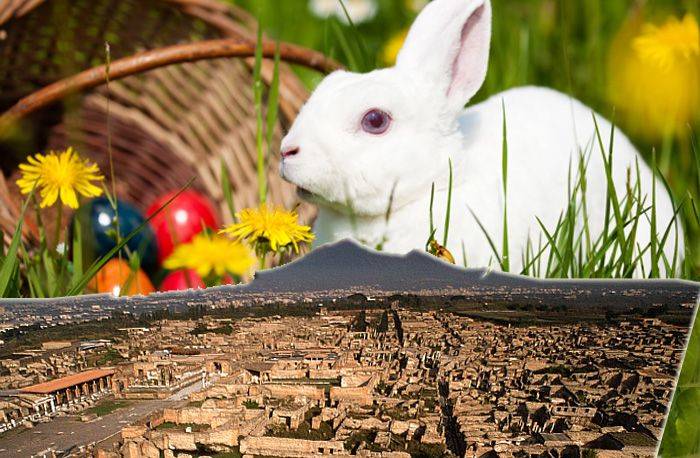In Italy's Easter Basket
ROME - Italy's Easter basket is filled with treasures. As a repository of works of art and archaeology, the nation tops the UNESCO World Heritage listing, with 49 officially recognized sites--more than any other country. Prehistoric wall paintings, Etruscan tombs, Hellenistic temples, Roman mosaics and paintings, illuminated medieval manuscripts, and Renaissance and Baroque paintings and statues are proudly displayed in museums and private collections worldwide.
This rich heritage is the national wealth, but it requires enormous dedication to maintenance, all the more difficult given the age of many of the sites and the fragility of the geology, whose seismic risks are the subject this week of an important scientific meeting in Naples. What is to be done? For ideas, please meet businesswoman cum politician Ilaria Borletti Buitoni, 59. Since February, Borletti Buitoni has served as Premier Matteo Renzi's undersecretary at the Ministry for the Cultural Heritage and Tourism; before this she held the same position under the previous premier Enrico Letta. Reflecting that experience as well as looking to the future, Borletti Buitoni has just published a pungent book called "Con la Cultura (non) si mangia? Quello che avrei voluto fare e non ho potuto e perche'" (Can or can't culture help give you a meal? What I'd have liked to do but couldn't). In it she provides sketches of sixteen difficult situations she saw from inside the box of the Culture Ministry, and which hinder heritage protection. Among these she lists:
. no provision for fiscal incentives for private projects;
. the irrational disorganization of museum ticketing;
. the failure to permit and encourage cultural volunteering; and
. under development of archeological parks.
In her previous book, she made a similar plea: "Per un'Italia possibile. La cultura salvera' il nostro paese?" (For a Possible Italy: Will culture save our country?) In that book, published in 2012, she wrote that, " For centuries the evidence of our identity and cultural industry were acknowledged all over the world. Its current vilification and neglect have been mistakes that have imposed limits upon the development of a type of tourism adapted to our country, and eliminated that sense of national pride so badly needed today." In recent years, she concludes, instead of being helpful, the tourism economy has pointed up our weaknesses. The appropriate cultural heritage and landscape of countless territories has been left unprotected, when not cemented over or completely neglected. The result: "A fair portion of the peninsula has taken no benefit from the new possibilities of development tourism offers."
Pompeii has overly well developed tourism, but its years of moral and physical lapses are taken by some outsiders, perhaps erroneously, as a sad metaphor for the country itself. Pompeii is a formidable challenge, with 1,500 buildings to be maintained, from monuments to shops and thermal baths and homes, plus 17,000 square meters of paintings, 20,000 square meters of plasterwork, and 2 million cubic meters of wall. All require constant attention, even as the ground beneath the city trembles with tiny, daily quakes.
In 1800 BC the Bronze Age villages in the vicinity of Pompeii were destroyed by an eruption of Mount Vesuvius. Then, in 62 AD, an earthquake shattered half the houses of Pompeii. Reconstruction was still underway when the eruption of 79 AD completely destroyed the city. Moreover, while it is simple to bemoan the collapse of a wall at Pompeii, it is to be recalled that some of its walls have been exposed to the elements for 250 or more years. Methods of restoration and protection once thought correct, such as steel beams and concrete, are now accused of having aggravated the problem.
Who has the responsibility for the tough job of maintaining the heritage? By law, the Italian state because the heritage is the property of all citizens. But, as Eugenio Scalfari, the 90-something founder of Italy's largest-selling newspaper, La Repubblica, wrote last Nov. 11: |"Culture, scholarly research, the cultural heritage, the public patrimony, the landscape--all these are considered optionals that one can do without. It's not so much about the expense, but about investments." By its nature, he goes on to say, investing in the heritage is not something that can simply be dropped without serious damage. "Unfortunately the conditions in which the heritage Superintendents work are as miserable as can be imagined. Personnel is reduced to a minimum, retirees are not replaced, services are almost non-existent."
This is true. The past five years of economic recession have worsened the situation. Increasingly, however, those responsible for the Italian heritage are beginning to look to private sources not only as sponsors, but also as companies who give without getting a return. Everyone's favorite example is the Packard Foundation's thirteen years of generous contributions to successful improvements at Herculaneum. Another, newer example of private and public working together is the agreement signed April 3 between Italy's leading high-tech company Finmeccanica and the Ministry to donate innovative technologies and services to monitor and to protect Pompeii. Its subsidiary company Telespazio will watch over the site from space while Selex ES will provide sensors to detect danger to the stability of buildings as well as to the painted plaster surfaces.
Thank you, Easter bunny.





































i-Italy
Facebook
Google+
This work may not be reproduced, in whole or in part, without prior written permission.
Questo lavoro non può essere riprodotto, in tutto o in parte, senza permesso scritto.